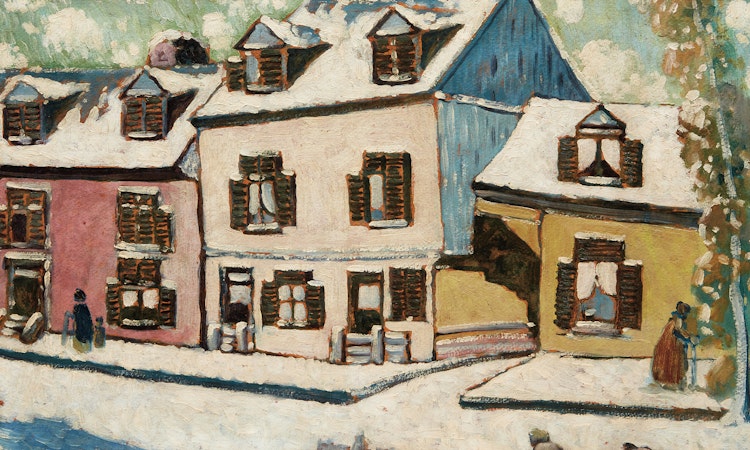Wolf Street, Montreal by Marc-Aurèle Fortin

Marc-Aurèle Fortin
Wolf Street, Montreal
oil on board
13 x 22 ins ( 33 x 55.9 cms )
Auction Estimate: $20,000.00 - $30,000.00
Price Realized $23,600.00
Sale date: September 24th 2020
Acquired directly from the artist by Dr. Gaston Maillet, Montreal
Roger Maillet, Montreal
Mlle Andrée Maillet, Montreal
By descent to a Private Collection, Montreal
Heffel Fine Art, auction, Vancouver, May 27, 2004, Lot 57
Canadian Corporate Collection, Ontario
Fortin’s oil painting provides an interesting glimpse into Montreal’s history, for these buildings on Wolfe Street no longer exist today. Located slightly east of downtown, the street served as the western border of the little-known neighbourhood that was demolished in the early 1960s to build the Radio-Canada office tower. Inhabited by a French-Canadian population working in the manufacturing industry, the area was nicknamed “Faubourg à m’lasse”, due to the supposed smell of barrels of molasses that were often being unloaded. The neighbourhood consisted of old houses and factories, characterized by the specific architecture and stone masonry that can be seen in Fortin’s work. La Societé Radio-Canada had been searching for a downtown location and it was concluded that this neighbourhood was better off being demolished than being revitalized. “Wolf Street, Montreal” serves as a souvenir of the city’s historic neighbourhoods that are all but forgotten today.
This artwork was painted circa 1918-1920.
Share this item with your friends
Marc-Aurèle Fortin
(1888 - 1970) RCA, ARCA
Born in Ste-Rose, north of Montreal, Marc-Aurèle Fortin studied art in the evenings while he made a living. His father was a judge and did not approve of his son studying art because he thought it was not a practical way of making a living. He attended the Ecole du Plateau, where he studied under Ludger Larose (1906-1908) and at the Council of Arts & Manufactures, Montreal under Edmond Dyonnet.
Around 1908, he became employed by the post office department in Montreal and from there travelled west to Edmonton, where he worked as a bank clerk and at several other jobs until he saved enough money to go to the United States for study at the Art Institute of Chicago with Edward J. Timmons (c. 1910), also studying in New York City and Boston.
Fortin returned to Montreal in 1914. He painted landscapes at Ste-Rose as well as at Piedmont and Montreal Harbour. He made a short trip to France and England (1920-22), which influenced his style. He exhibited in Chicago (1929) and at Pretoria, South Africa (1930). In 1935, he was again in Europe, where he painted in southern France and northern Italy.
On his return to Canada, he exhibited at T. Eaton Company in Montreal. During one of his exhibitions in 1937, St. George Burgoyne of “The Gazette” noted. “…Mr. Fortin is courageous; individual and an experimenter and many of the works on view suggest that the treatment might conceivably be more effective if employed on big scale decorations, rather than on pictures for the embellishment of the average room…” Burgoyne, in a 1938 review, praised his resourcefulness in finding new pictorial angles particularly in his water colours and also how effective were his smaller harbour scenes. It was during this year that Fortin’s work was chosen for the exhibit at the Tate Gallery, London, in “A Century of Canadian Art”. He received further recognition at the Montreal Museum of Fine Art’s Spring Exhibition in 1938 for his water colour landscape, “Les Eboulements” (1938), which won the Jessie Dow Prize.
He won a bronze medal at the N.Y. World’s Fair (1939). In 1945, he took part in the show, “Canadian Art in Brazil”, when Marcelle-Louis Proux, writing in the Planalto of Sao Paulo, noted, “He is a brilliant colourist, who looks on painting as a ‘plastic poetry’.” By this time, he had made trips to the Gaspé, Baie-Saint-Paul, and Lac St-Jean regions.
In 1955, Fortin became ill and stopped painting for seven years. His legs had to be amputated. He began his long road to recovery and painted from his wheelchair. Writing on his 1963 retrospective show at the Mount Royal Art Centre, Raymond Heard reflected, “A gentle and nostalgic world is reflected in Mr. Fortin’s canvases. It is a world of curdled clouds and patchwork field in which anonymous rustics labor in the shadow of lonely, wind-tossed elms. When he turns his eye to the city, Mr. Fortin sees rows of quaint Old World dwellings in Quebec, or broad views of Montreal in the days before the urban sprawl scrambled much of the beauty into an untidy blur of smoke and concrete.”
In 1963, a retrospective show of Fortin’s work was held at the National Gallery of Canada and in the exhibition catalogue, Jean-René Ostiguy noted, “After his trip to Europe, when his style came close to resembling that of the Group of Seven, he succeeded in preserving a quality of expression belonging to the people, a kind of crudeness which is regarded by some as violent but which really resulted from his brusque execution of his work…. Fortin oscillated between decorative imagery and Fauvism. When he was at his best, he mingled the two…”
Literature Source:
"A Dictionary of Canadian Artists, Volume 1: A-F, 5th Edition, Revised and Expanded", compiled by Colin S. MacDonald, Canadian Paperbacks Publishing Ltd, Ottawa, 1997

